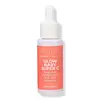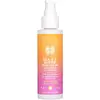What's inside
What's inside
 Key Ingredients
Key Ingredients

 Benefits
Benefits

 Concerns
Concerns

 Ingredients Side-by-side
Ingredients Side-by-side

Water
Skin ConditioningAscorbic Acid
AntioxidantGlycerin
HumectantCetyl Alcohol
EmollientSqualane
EmollientHelianthus Annuus Seed Oil
EmollientTocopheryl Acetate
AntioxidantStearyl Alcohol
EmollientGlycolipids
Skin ConditioningGlyceryl Stearate Citrate
EmollientGlyceryl Laurate
EmollientTocopherol
AntioxidantBoswellia Serrata Resin Extract
SmoothingTerminalia Ferdinandiana Fruit Extract
AntioxidantAlgin
MaskingBisabolol
MaskingGlyceryl Stearate
EmollientSodium Phytate
Xanthan Gum
EmulsifyingPhenoxyethanol
PreservativeSodium Riboflavin Phosphate
Skin ConditioningEthylhexylglycerin
Skin ConditioningWater, Ascorbic Acid, Glycerin, Cetyl Alcohol, Squalane, Helianthus Annuus Seed Oil, Tocopheryl Acetate, Stearyl Alcohol, Glycolipids, Glyceryl Stearate Citrate, Glyceryl Laurate, Tocopherol, Boswellia Serrata Resin Extract, Terminalia Ferdinandiana Fruit Extract, Algin, Bisabolol, Glyceryl Stearate, Sodium Phytate, Xanthan Gum, Phenoxyethanol, Sodium Riboflavin Phosphate, Ethylhexylglycerin
Octocrylene 2.9%
UV AbsorberWater
Skin ConditioningButyloctyl Salicylate
Skin ConditioningCoconut Alkanes
EmollientCalcium Sodium Borosilicate
Cetearyl Alcohol
EmollientParfum
MaskingPropanediol
SolventAscorbic Acid
AntioxidantTocopherol
AntioxidantAscophyllum Nodosum Extract
Skin ConditioningAlgae Extract
EmollientWithania Somnifera Root Extract
Skin ConditioningAloe Barbadensis Leaf Juice
Skin ConditioningCaffeine
Skin ConditioningCaprylhydroxamic Acid
Caprylyl Glycol
EmollientCellulose Gum
Emulsion StabilisingCoco-Caprylate/Caprate
EmollientCoco-Glucoside
CleansingEthyl Ferulate
AntioxidantFructose
HumectantGlycerin
HumectantGlyceryl Stearate
EmollientLauroyl Lysine
Skin ConditioningMicrocrystalline Cellulose
AbsorbentSodium Gluconate
Skin ConditioningSodium Stearoyl Glutamate
CleansingXanthan Gum
EmulsifyingOctocrylene 2.9%, Water, Butyloctyl Salicylate, Coconut Alkanes, Calcium Sodium Borosilicate, Cetearyl Alcohol, Parfum, Propanediol, Ascorbic Acid, Tocopherol, Ascophyllum Nodosum Extract, Algae Extract, Withania Somnifera Root Extract, Aloe Barbadensis Leaf Juice, Caffeine, Caprylhydroxamic Acid, Caprylyl Glycol, Cellulose Gum, Coco-Caprylate/Caprate, Coco-Glucoside, Ethyl Ferulate, Fructose, Glycerin, Glyceryl Stearate, Lauroyl Lysine, Microcrystalline Cellulose, Sodium Gluconate, Sodium Stearoyl Glutamate, Xanthan Gum
Ingredients Explained
These ingredients are found in both products.
Ingredients higher up in an ingredient list are typically present in a larger amount.
Ascorbic Acid is is pure Vitamin C. This form makes up the largest amount of vitamin C found naturally in our skin.
Not only is vitamin C great for your overall health and immune system, it also has plenty of benefits on your skin.
Vitamin C is best used for brightening skin. It improves dark spots, acne scars, and hyperpigmentation. This is because it blocks the process of skin darkening when exposed to UV.
Remember: Vitamin C should not replace sunscreen!
Your skin uses vitamin C to build collagen. Collagen is one key component in having a strong skin barrier and plump skin. Vitamin C also plays a role in regulating collagen, thus making it effective in improving wrinkles and fine lines.
Ascorbic acid shows potent antioxidant activity. As an antioxidant, it helps fight free-radicals. Free-radicals are molecules that may damage your skin cells. These antioxidants also protect skin against UV damage.
The best formulations include Vitamin E and/or ferulic acid. These two ingredients help stabilize and provide a boost in the benefits of ascorbic acid. This is because ascorbic acid becomes unstable when exposed to UV and air. In fact, you can tell your ascorbic acid has oxidized when it turns an orange-yellow color.
Ascorbic acid is generally compatible with other ingredients. However, using ascorbic acid with other active ingredients might cause irritation. Two ingredients: copper ions and benzoyl peroxide, will inactivate ascorbic acid completely.
Read more about other types of Vitamin C:
Foods rich with vitamin C include oranges, strawberries, broccoli, bell peppers, and more. When consuming Vitamin C, your skin receives a portion of the nutrients.
Learn more about Ascorbic AcidGlycerin is already naturally found in your skin. It helps moisturize and protect your skin.
A study from 2016 found glycerin to be more effective as a humectant than AHAs and hyaluronic acid.
As a humectant, it helps the skin stay hydrated by pulling moisture to your skin. The low molecular weight of glycerin allows it to pull moisture into the deeper layers of your skin.
Hydrated skin improves your skin barrier; Your skin barrier helps protect against irritants and bacteria.
Glycerin has also been found to have antimicrobial and antiviral properties. Due to these properties, glycerin is often used in wound and burn treatments.
In cosmetics, glycerin is usually derived from plants such as soybean or palm. However, it can also be sourced from animals, such as tallow or animal fat.
This ingredient is organic, colorless, odorless, and non-toxic.
Glycerin is the name for this ingredient in American English. British English uses Glycerol/Glycerine.
Learn more about GlycerinGlyceryl Stearate is a mix of glycerin and stearic acid.
It is used to stabilize the mixing of water and oil ingredients. By preventing these ingredients from separating, it can help elongate shelf life. It can also help thicken the product's texture.
As an emollient, it helps soften skin and supports barrier-replenishing ingredients.
In cosmetics, Glyceryl Stearate is often made from vegetable oils or synthetically produced.
This ingredient may not be fungal-acne safe
Fun fact: The human body also creates Glyceryl Stearate naturally.
Learn more about Glyceryl StearateTocopherol (also known as Vitamin E) is a common antioxidant used to help protect the skin from free-radicals and strengthen the skin barrier. It's also fat soluble - this means our skin is great at absorbing it.
Vitamin E also helps keep your natural skin lipids healthy. Your lipid skin barrier naturally consists of lipids, ceramides, and fatty acids. Vitamin E offers extra protection for your skin’s lipid barrier, keeping your skin healthy and nourished.
Another benefit is a bit of UV protection. Vitamin E helps reduce the damage caused by UVB rays. (It should not replace your sunscreen). Combining it with Vitamin C can decrease sunburned cells and hyperpigmentation after UV exposure.
You might have noticed Vitamin E + C often paired together. This is because it is great at stabilizing Vitamin C. Using the two together helps increase the effectiveness of both ingredients.
There are often claims that Vitamin E can reduce/prevent scarring, but these claims haven't been confirmed by scientific research.
Learn more about TocopherolWater. It's the most common cosmetic ingredient of all. You'll usually see it at the top of ingredient lists, meaning that it makes up the largest part of the product.
So why is it so popular? Water most often acts as a solvent - this means that it helps dissolve other ingredients into the formulation.
You'll also recognize water as that liquid we all need to stay alive. If you see this, drink a glass of water. Stay hydrated!
Learn more about WaterXanthan gum is used as a stabilizer and thickener within cosmetic products. It helps give products a sticky, thick feeling - preventing them from being too runny.
On the technical side of things, xanthan gum is a polysaccharide - a combination consisting of multiple sugar molecules bonded together.
Xanthan gum is a pretty common and great ingredient. It is a natural, non-toxic, non-irritating ingredient that is also commonly used in food products.
Learn more about Xanthan Gum